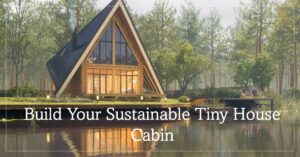Tiny House Communities: Unveiling Their Diversity and Locations
In a world that often equates success with bigger and better, a growing trend is quietly taking root, challenging conventional notions of homeownership and community living.
It’s the rise of tiny house communities, an enchanting world where less truly means more. In this article, we will take you on a journey to explore these hidden gems, revealing their charm and practicality while shedding light on where you can find them.
The Rise of Tiny House Living
Tiny house living may seem modern, but its roots trace history. From the cozy cottages of medieval Europe to the cabins of early American settlers, the idea of living simply has always been appealing.
In recent years, cultural shifts toward minimalism and a desire for more sustainable living have reignited interest in tiny homes. The economic and environmental benefits of downsizing have prompted many to reconsider their notions of “home sweet home.”
The Appeal of Tiny House Communities
One of the most compelling aspects of tiny house living is the sense of community it fosters. In these tight-knit communities, residents share physical space, values, and a sense of purpose. It’s a place where neighbors become friends, collaborative living is the norm, and the concept of “borrowing a cup of sugar” takes on a whole new meaning.
Beyond the social aspect, affordability and financial freedom are driving factors. Lower living costs in tiny houses can reduce debt, enabling residents to prioritize experiences and passions over mortgage payments. Sustainable living is another key draw, with tiny houses boasting a significantly reduced environmental footprint and often incorporating innovative energy-efficient designs.
Types of Tiny House Communities
Tiny house communities come in various forms to suit different lifestyles and preferences. Urban tiny-house villages can be found nestled in bustling cities, providing a unique blend of urban and small-space living.
Rural retreats offer a tranquil escape from the city, with breathtaking natural surroundings as your backdrop. Mobile tiny house communities offer a nomadic lifestyle for those seeking mobility and flexibility. And co-housing initiatives bring together like-minded individuals who value community while maintaining their independence.
Tiny house communities come in diverse forms, each catering to unique lifestyles and preferences. Exploring these various types can help you find the perfect fit for your tiny house adventure:
A. Urban Tiny House Villages: City Living, Tiny Style
Urban tiny house villages are charming oases amidst the hustle and bustle of urban life. These communities are often strategically located within or near cities, providing residents easy access to amenities, employment opportunities, and cultural attractions.
● Advantages:
- Proximity to city conveniences.
- Vibrant social scene.
- Opportunities for urban exploration.
● Considerations:
- Limited space compared to rural counterparts.
- Higher land costs.
B. Rural Retreats: Embrace Tranquility in Nature
Rural tiny house communities are idyllic getaways set in picturesque natural landscapes. These retreats offer a serene escape from the chaos of city living, allowing residents to live closer to nature. These communities often promote sustainable living practices and self-sufficiency.
● Advantages:
- Peaceful, natural surroundings.
- Sustainable living opportunities.
- Space for gardening and outdoor activities.
● Considerations:
- Limited access to urban amenities.
- Potential for longer commutes.
C. Mobile Tiny House Communities: Life on the Move
Mobile tiny house communities are designed for those with an insatiable sense of wanderlust. These communities allow residents to take their homes wherever their hearts desire. Whether it’s exploring the open road or changing scenery with the seasons, mobility is the name of the game here.
● Advantages:
- Ultimate flexibility and adventure.
- Minimal commitment to a single location.
- Opportunity to connect with diverse communities.
● Considerations:
- Challenges with zoning and parking.
- Limited space for possessions.
D. Co-Sharing Initiatives: Sharing is Caring
Co-housing initiatives foster a unique blend of community living and independence. In these setups, individuals or families have their tiny homes but share common spaces and resources, promoting a strong sense of collaboration and communal living.
● Advantages:
- Strong sense of community.
- Shared responsibilities and resources.
- Enhanced social interactions.
● Considerations:
- Balancing individual privacy with communal living.
- Establishing clear rules and guidelines.
These various types of tiny house communities cater to a spectrum of preferences and lifestyles, making it possible for individuals to find their ideal balance between simplicity, community, and location.
Whether you yearn for the vibrancy of city life, the tranquility of nature, the freedom of the open road, or a harmonious blend of community and independence, there’s a tiny house community to suit your vision of home.
Where Are They Located?
Tiny house communities can be found worldwide, but they are most prevalent in the United States, particularly in the Pacific Northwest, where the movement gained significant momentum. Southern states and northeastern regions also host their fair share of these communities. Internationally, Europe, Australia, and even some parts of Asia have embraced the tiny house lifestyle.
Tiny house communities can be found across the United States and in various parts of the world. These charming communities have gained popularity for their unique approach to living sustainably. Let’s explore where you can discover these tiny havens:
A. United States
1. Pacific Northwest
The Pacific Northwest region of the United States, encompassing states like Oregon and Washington, is considered the birthplace of the modern tiny house movement. Here, lush forests, a mild climate, and a culture that values sustainability have made it a hotspot for tiny house enthusiasts. You’ll find a variety of communities, from urban villages in Portland to remote woodland retreats in Washington.
2. Southern States
The southern states of the U.S., including Texas and Georgia, have also embraced tiny house living. These communities offer a warmer climate, making year-round outdoor living more feasible. Whether you’re interested in lakeside living or the charm of the Deep South, you can find tiny house communities with a Southern twist.
3. Northeastern Regions
Tiny house communities have begun to take root in the northeastern states such as Vermont, New York, and Massachusetts. Here, the focus often includes sustainable living and a connection to the area’s natural beauty. These communities offer an escape from city life while still within reach of urban amenities.
B. International Communities
1. Europe
Europe has embraced the tiny house movement, with communities in countries like France, the Netherlands, and the United Kingdom. European tiny house villages often blend modern design with rustic charm, offering a unique take on minimalist living.
2. Australia
Australia has also embraced tiny house living, especially in rural and coastal areas. You can find tiny house communities near stunning beaches or in the Australian bush, providing a blend of natural beauty and community living.
3. Asia
While the tiny house movement is still emerging in Asia, countries like Japan have started to explore the concept. Japanese communities often prioritize efficient use of space and integrate traditional design elements into their tiny homes.
These locations are just a glimpse into the growing global map of tiny house communities. Whether you’re dreaming of a tiny house in the Pacific Northwest, a European-inspired village, or an escape to the Australian wilderness, there are diverse options available for those seeking the joys of simple living in a close-knit community, no matter where in the world your wanderlust takes you.
Challenges and Legal Considerations
While the allure of tiny house living is undeniable, it’s not without challenges. Zoning and regulatory hurdles often pose significant obstacles for those looking to establish or join tiny house communities. Infrastructure and utilities can also be tricky to navigate in more remote locations. Community governance, while fostering a sense of togetherness, may require clear guidelines to ensure harmony among residents.
The Future of Tiny House Communities
As the popularity of tiny house living continues to grow, so does the potential for expansion and innovation. Expect more innovative designs and construction techniques that maximize space and sustainability. Policy changes and advocacy efforts are also on the horizon, aiming to make tiny house living more accessible and accepted in a broader range of locations.
Conclusion
Tiny house communities are a hidden treasure in the world of housing options. They offer a sense of belonging, financial freedom, and sustainable living that resonates with an ever-increasing number of individuals.
Whether you’re an urban dweller or a nature enthusiast, a tiny house community is likely waiting to welcome you with open arms. So, why not look closely at these remarkable communities and see if they might hold the key to your perfect “home sweet home.”




